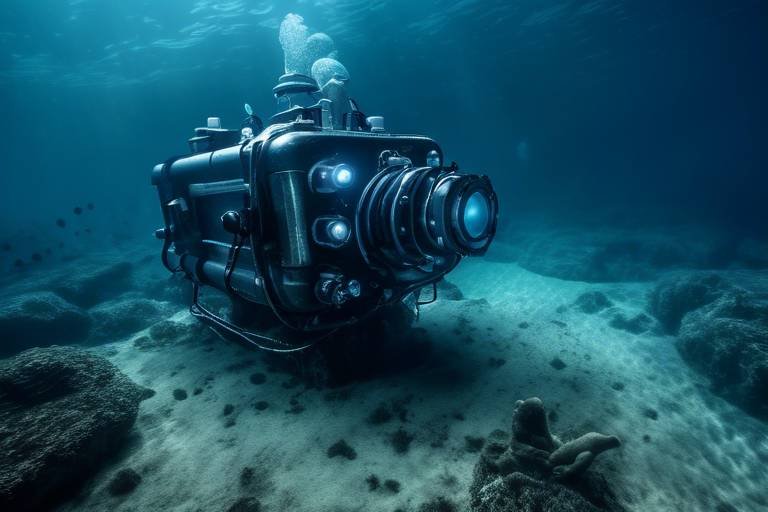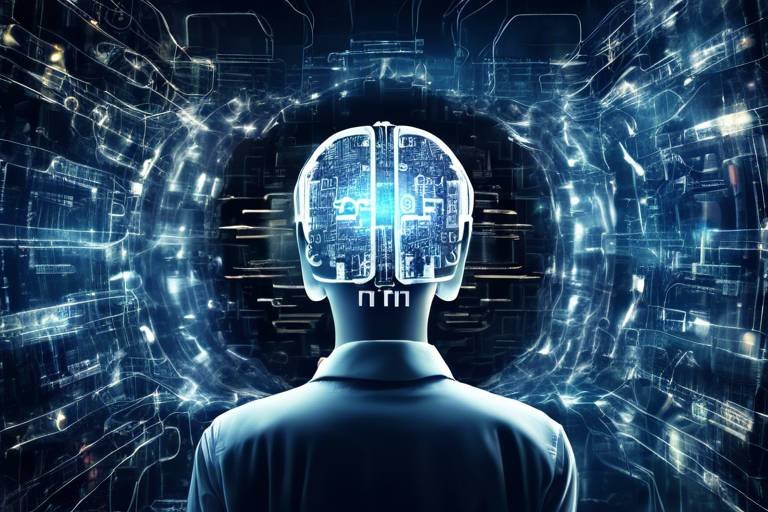Role of AI in Underwater Exploration
In recent years, the ocean has become a frontier of discovery, much like outer space once was. With over 70% of our planet covered in water, the mysteries of the deep remain largely unexplored. This is where artificial intelligence (AI) steps in, acting as a powerful ally in the quest to unveil the secrets hidden beneath the waves. Imagine AI as a digital scuba diver, equipped with the ability to analyze, learn, and adapt, making underwater exploration not only more efficient but also more insightful. From autonomous underwater vehicles (AUVs) to sophisticated data analysis tools, AI is transforming how we interact with marine environments, offering unprecedented opportunities to study biodiversity, assess environmental changes, and enhance conservation efforts.
The impact of AI on underwater exploration is multifaceted. For instance, AI technologies are enabling robots to navigate complex underwater terrains autonomously, collecting data that was previously challenging to obtain. This advancement is akin to giving a human diver a superpower—enhanced vision and the ability to operate in conditions that would otherwise be impossible. The result? A treasure trove of data regarding marine ecosystems, which can be harnessed for research, conservation, and even commercial purposes.
Furthermore, AI's role extends beyond mere navigation. It is also revolutionizing the way we analyze the massive amounts of data collected from these underwater missions. Traditional methods of data analysis can be time-consuming and often miss critical patterns. However, with machine learning algorithms at the helm, researchers can sift through vast datasets with speed and precision, identifying trends and anomalies that may indicate changes in marine life or environmental conditions. This capability is crucial, especially as we face the pressing challenges of climate change and habitat degradation.
As we delve deeper into the ocean's depths, AI is also enhancing communication systems among autonomous vehicles and research teams. Think of it as upgrading from a walkie-talkie to a smartphone—information can be shared in real-time, allowing for better coordination and decision-making during missions. This improvement not only streamlines operations but also ensures that valuable data is not lost in the depths of the ocean.
In summary, the role of AI in underwater exploration is pivotal. It is not just about discovering new species or mapping the ocean floor; it is about understanding the intricate web of life that exists beneath the surface. As we continue to innovate and integrate AI technologies into our exploratory efforts, we are not only enhancing our knowledge but also fostering a deeper appreciation for the marine environments that are vital to our planet's health.
- How does AI improve underwater exploration? AI enhances navigation, data collection, and analysis, making underwater missions more efficient and insightful.
- What are the main applications of AI in marine research? AI is used in autonomous navigation, data analysis, image recognition, and real-time monitoring of marine ecosystems.
- What challenges does AI face in underwater exploration? Challenges include data quality, hardware limitations, and the complexity of underwater environments.
- Are there ethical concerns with using AI in marine research? Yes, balancing technological advancement with environmental protection and marine life welfare is essential.
- What does the future hold for AI and underwater exploration? Future trends include improved predictive capabilities and enhanced sensor technologies for deeper ocean understanding.

AI Technologies in Underwater Robotics
Artificial Intelligence (AI) is making significant waves in the realm of underwater robotics, and it's fascinating to witness how these technologies are reshaping our understanding of the deep blue sea. Imagine sending a robot into the ocean that can not only navigate through the murky depths but also gather critical data about marine life and ecosystems. This is no longer science fiction; it’s happening right now! With advancements in AI, underwater robots are becoming more autonomous, efficient, and capable of performing complex tasks that were once thought impossible.
One of the major breakthroughs in this field is the integration of machine learning algorithms into underwater vehicles. These algorithms allow robots to learn from their environment and adapt their behaviors accordingly. For instance, if a robot encounters an unexpected obstacle, it can analyze the situation and determine the best course of action without human intervention. This level of autonomy is crucial for exploring areas that are difficult or dangerous for human divers to reach.
Additionally, AI technologies enhance the navigation capabilities of underwater robots. Traditional navigation methods often rely on GPS, which is ineffective underwater due to signal loss. However, AI-powered systems utilize sonar and computer vision to create detailed maps of the underwater terrain. This technology not only helps robots navigate but also enables them to avoid hazards, making underwater exploration safer and more efficient.
Moreover, the data collection and analysis capabilities of these robots have improved dramatically. Equipped with advanced sensors and imaging tools, AI-driven underwater robots can capture high-resolution images and collect environmental data, such as temperature, salinity, and pressure. This data is invaluable for researchers studying marine ecosystems and assessing the impacts of climate change. By processing this information through AI algorithms, scientists can gain insights into patterns and trends that would be impossible to detect manually.
To illustrate the transformative impact of AI in underwater robotics, consider the following table that highlights some key AI technologies and their applications:
| AI Technology | Application |
|---|---|
| Machine Learning | Autonomous navigation and obstacle avoidance |
| Computer Vision | Image recognition and environmental mapping |
| Sensor Fusion | Data collection for environmental monitoring |
| Predictive Analytics | Forecasting ecological changes |
In summary, AI technologies are not just enhancing the capabilities of underwater robotics; they are fundamentally changing how we explore and understand the ocean. As these technologies continue to evolve, we can expect even more exciting developments in underwater exploration, leading to discoveries that could reshape our knowledge of marine life and ecosystems.

Data Analysis and Machine Learning
In the vast, uncharted territories of our oceans, data analysis and machine learning are emerging as the unsung heroes of underwater exploration. Imagine diving deep into the ocean, surrounded by a world teeming with life, yet hidden from our view. The challenge lies in understanding and interpreting the colossal amounts of data collected by underwater vehicles and sensors. This is where machine learning steps in, acting like a skilled translator that deciphers the complex language of marine ecosystems. By harnessing advanced algorithms, researchers can sift through terabytes of data, identifying patterns and trends that would be nearly impossible to spot manually.
One of the most significant advantages of machine learning is its ability to learn and adapt over time. As more data is collected, these algorithms refine their predictions and analyses, becoming increasingly accurate. For example, researchers can use machine learning to track the migration patterns of various marine species. By analyzing historical data alongside real-time information, scientists can predict future movements and behaviors. This capability is crucial for conservation efforts, as it allows for better planning and resource allocation to protect vulnerable species.
Consider the role of image recognition in this context. AI-driven tools can analyze thousands of underwater images in a fraction of the time it would take a human. These tools can identify and classify marine species, making biodiversity assessments more efficient. For instance, a single underwater drone might capture thousands of images during a mission. Instead of a team of researchers painstakingly sorting through each image, machine learning algorithms can automate this process, flagging and categorizing species with remarkable speed and accuracy.
To illustrate the impact of machine learning on underwater exploration, let’s take a look at a simplified example:
| Data Type | Traditional Analysis | Machine Learning Analysis |
|---|---|---|
| Species Identification | Manual sorting of images | Automated classification using algorithms |
| Environmental Monitoring | Periodic data collection | Continuous real-time analysis |
| Behavior Tracking | Single observation | Predictive modeling based on historical data |
As shown in the table, the shift from traditional analysis to machine learning not only enhances efficiency but also significantly improves the quality of insights gained from underwater exploration. With real-time data analysis, researchers can respond more swiftly to environmental changes, making informed decisions that can lead to effective conservation strategies.
However, the journey doesn’t end here. The integration of machine learning into underwater exploration paves the way for exciting future possibilities. For instance, imagine AI systems predicting the impact of climate change on coral reefs or identifying areas most at risk due to human activity. By using predictive analytics, researchers can take proactive measures to mitigate these impacts, ensuring that our oceans remain vibrant and healthy for generations to come.
In summary, the fusion of data analysis and machine learning is transforming the way we explore and understand our oceans. As technology continues to evolve, so too will our ability to unlock the secrets of the deep, fostering a greater appreciation for the intricate ecosystems that thrive beneath the waves.

Image Recognition for Marine Species
In the vast and mysterious depths of our oceans, identifying and classifying marine species has long been a challenging task for researchers. However, with the advent of AI-driven image recognition tools, this process has become significantly more efficient and accurate. Imagine a world where a simple photograph taken underwater can instantly reveal the species of fish swimming by, or where researchers can catalog marine biodiversity without hours of tedious manual work. This is no longer a distant dream; it's happening right now, thanks to the incredible capabilities of artificial intelligence.
AI image recognition systems utilize complex algorithms to analyze visual data, enabling them to recognize patterns and features in images that are often invisible to the human eye. These systems are trained on vast datasets of marine life images, allowing them to learn and adapt over time. As a result, they can accurately identify various species, from the majestic blue whale to the tiniest plankton. This technology not only speeds up the identification process but also enhances the overall accuracy of biodiversity assessments.
Furthermore, the implications of this technology extend beyond mere identification. By streamlining the process of cataloging marine species, AI image recognition plays a crucial role in conservation efforts. For instance, researchers can quickly assess the health of marine ecosystems, track endangered species, and monitor changes in biodiversity over time. This data is invaluable for formulating effective conservation strategies and ensuring the protection of vulnerable marine habitats.
To illustrate the impact of AI image recognition on marine research, consider the following table that highlights some of its key benefits:
| Benefit | Description |
|---|---|
| Increased Efficiency | Reduces the time needed for species identification, allowing researchers to focus on analysis and conservation. |
| Enhanced Accuracy | Minimizes human error in species classification, leading to more reliable data. |
| Real-time Data Collection | Facilitates immediate identification during underwater missions, providing timely insights. |
| Support for Citizen Science | Empowers non-experts to contribute to marine research by identifying species using mobile apps. |
In addition to these benefits, AI image recognition is paving the way for exciting developments in citizen science. With user-friendly applications, everyday people can now participate in marine research by simply snapping photos of marine life during their beach outings or snorkeling adventures. This democratization of data collection not only enhances public awareness of marine conservation but also enriches the data pool available for scientific study.
As we look to the future, the potential of AI in marine species identification is boundless. The integration of image recognition with other technologies, such as machine learning and data analytics, will further enhance our ability to understand and protect marine ecosystems. By harnessing the power of AI, we are not just observing the ocean; we are actively participating in its preservation and exploration.
- What is AI image recognition?
AI image recognition refers to the use of artificial intelligence to analyze and identify objects, patterns, and features in images. - How does AI help in marine species identification?
AI algorithms can quickly analyze underwater images to identify and classify various marine species, improving efficiency and accuracy. - Can anyone use AI tools for marine research?
Yes! Many AI applications are designed for non-experts, allowing anyone to contribute to marine research through citizen science initiatives. - What are the benefits of using AI in marine conservation?
AI helps in faster data collection, enhanced accuracy, and supports conservation efforts by providing critical insights into marine biodiversity.

Automated Monitoring Systems
In the realm of underwater exploration, powered by artificial intelligence are proving to be game-changers. Imagine a network of intelligent devices that can continuously observe the depths of our oceans, gathering crucial data without the need for constant human intervention. These systems are equipped with advanced sensors and AI algorithms that enable them to track environmental changes, monitor marine life, and assess the health of underwater ecosystems in real-time.
One of the most remarkable features of these monitoring systems is their ability to operate autonomously. This means that they can be deployed in remote areas of the ocean where human access is limited or impossible. For instance, a fleet of autonomous underwater vehicles (AUVs) can be sent on missions to collect data from the deep sea, mapping the ocean floor, and recording temperature and salinity levels, all while navigating complex underwater terrains. This not only enhances the efficiency of data collection but also minimizes the risks associated with human divers working in hazardous conditions.
Moreover, these systems are designed to process and analyze data on-the-fly. With the integration of machine learning algorithms, they can identify patterns and anomalies in the data being collected. For example, if an AUV detects an unusual spike in water temperature, it can immediately alert researchers to a potential environmental threat, such as a coral bleaching event or the presence of pollutants. This capability allows scientists to respond proactively to changes in marine environments, rather than reacting after the fact.
Another significant advantage of automated monitoring systems is their ability to provide long-term data collection. Unlike traditional methods, which often rely on sporadic human-led expeditions, these systems can operate continuously over extended periods. This long-term data is invaluable for understanding seasonal changes in marine ecosystems and assessing the impacts of climate change. By compiling extensive datasets, researchers can make more accurate predictions and informed decisions about conservation efforts.
To illustrate the impact of automated monitoring systems, consider the following table that summarizes their key features and benefits:
| Feature | Benefit |
|---|---|
| Autonomous Operation | Reduces the need for human presence in dangerous underwater environments. |
| Real-Time Data Processing | Enables immediate response to environmental changes and threats. |
| Long-Term Monitoring | Provides comprehensive data for analyzing trends and making informed decisions. |
| Advanced Sensors | Enhances the accuracy of data collected on various marine parameters. |
In summary, automated monitoring systems represent a significant leap forward in our ability to explore and understand underwater environments. As technology continues to evolve, we can expect these systems to become even more sophisticated, offering deeper insights into the mysteries of the ocean. The integration of AI not only streamlines data collection but also empowers researchers to make timely and informed decisions that can help protect our precious marine ecosystems.
- What are automated monitoring systems? Automated monitoring systems are AI-powered devices that continuously observe underwater environments, gathering and analyzing data without human intervention.
- How do they improve underwater exploration? They enhance exploration by providing real-time data, operating autonomously in remote areas, and enabling long-term monitoring of marine ecosystems.
- What kind of data can they collect? These systems can collect data on temperature, salinity, water quality, and marine life, among other parameters.
- Are they safe for marine life? Yes, these systems are designed to minimize disruption to marine ecosystems while providing valuable insights for conservation efforts.

Predictive Analytics in Marine Research
Predictive analytics is a game-changer in the field of marine research, offering researchers the ability to foresee changes in marine ecosystems before they occur. Imagine being able to predict a storm's impact on coral reefs or the migration patterns of fish based on environmental data! This technology leverages machine learning algorithms and vast datasets to identify trends and make forecasts, which can be incredibly beneficial for conservation efforts and resource management.
By analyzing historical data alongside real-time observations, predictive models can help scientists understand the intricate relationships within marine environments. For instance, researchers can assess how temperature fluctuations may affect fish populations or how pollution levels might impact coral health. The potential applications of predictive analytics are vast, ranging from improving fishing practices to enhancing the resilience of marine ecosystems against climate change.
Moreover, predictive analytics enables the development of proactive strategies. Rather than waiting for an environmental crisis to occur, scientists can implement measures to mitigate risks. For example, if predictive models indicate a potential decline in a fish species due to overfishing, regulations can be adjusted accordingly to ensure sustainable practices. This foresight is crucial for preserving biodiversity and maintaining the health of our oceans.
To illustrate the impact of predictive analytics, consider the following table showcasing some key benefits:
| Benefit | Description |
|---|---|
| Early Warning Systems | Predictive models can provide alerts about potential ecological threats, allowing for timely interventions. |
| Resource Management | Data-driven insights help in managing marine resources sustainably, balancing human needs with ecological preservation. |
| Enhanced Research Efficiency | Researchers can focus their efforts on areas that show the most significant potential for change, optimizing their time and resources. |
In summary, the integration of predictive analytics into marine research not only enhances our understanding of ocean dynamics but also empowers us to make informed decisions that protect marine life. As technology continues to evolve, the accuracy and reliability of these predictive models will only improve, paving the way for a more sustainable interaction with our oceans.
- What is predictive analytics in marine research? Predictive analytics involves using data and algorithms to forecast future events in marine environments, helping researchers make informed decisions.
- How does predictive analytics benefit marine conservation? It allows scientists to anticipate changes and implement proactive measures to protect marine ecosystems before crises occur.
- Can predictive analytics be applied to other fields? Yes, predictive analytics is widely used in various fields such as healthcare, finance, and weather forecasting, among others.

Enhancing Underwater Communication
When we think about underwater exploration, one of the biggest challenges that comes to mind is communication. Imagine trying to have a conversation while submerged in water—it's not easy, right? Well, the same goes for underwater robots and autonomous vehicles. AI is stepping in to revolutionize this aspect of marine exploration, making it easier for researchers and machines to communicate effectively. With advancements in AI-driven communication systems, we are witnessing a transformation that enhances data transfer and coordination among various underwater entities.
At the heart of this communication enhancement lies sophisticated algorithms that enable real-time data exchange. These algorithms are designed to optimize the transmission of information, ensuring that critical data reaches researchers on the surface without delays. For instance, consider a scenario where an autonomous underwater vehicle (AUV) is gathering data on ocean temperatures and salinity levels. With robust AI communication systems, the AUV can relay this information back to the research team instantaneously, allowing for timely decisions and actions.
Moreover, AI technologies facilitate improved coordination during underwater missions. Think of a symphony orchestra, where each musician plays their part in harmony. In a similar way, AI helps different autonomous vehicles and sensors to work together seamlessly. This coordination is essential, especially in complex underwater environments where multiple vehicles may be operating simultaneously. By using AI to manage these interactions, researchers can ensure that every piece of equipment is functioning optimally and contributing to the overall mission objectives.
One notable application of AI in underwater communication is the development of acoustic communication systems. These systems utilize sound waves to transmit data underwater, a method that has been around for some time but is now significantly enhanced by AI. By analyzing the acoustic signals, AI can improve the clarity and reliability of communications, even in challenging conditions. This is akin to tuning a radio to get a clearer signal—AI fine-tunes the communication channels to reduce noise and interference, allowing for clearer exchanges of information.
Furthermore, AI-driven communication systems can adapt to changing underwater conditions. For example, if a vehicle encounters turbulent waters or obstacles, the AI can adjust the communication protocols on-the-fly, ensuring that data continues to flow smoothly. This adaptability is crucial for maintaining operational efficiency and safety during missions.
In summary, enhancing underwater communication through AI is not just about transmitting data; it's about creating a cohesive network that allows researchers to gain deeper insights into marine environments. As we continue to develop these technologies, the possibilities for underwater exploration become even more exciting. The ocean is vast and mysterious, and with AI leading the charge in communication, we are better equipped than ever to unlock its secrets.
- How does AI improve communication in underwater exploration?
AI enhances communication by optimizing data transmission, improving coordination among vehicles, and adapting to changing underwater conditions. - What role do acoustic communication systems play in underwater exploration?
Acoustic communication systems use sound waves to transmit data underwater, and AI helps improve the clarity and reliability of these communications. - Can AI adapt to challenging underwater environments?
Yes, AI systems can adjust communication protocols in real-time to ensure data flow remains uninterrupted, even in turbulent conditions. - Why is coordination among autonomous vehicles important?
Coordination ensures that all equipment works together effectively, enhancing the overall efficiency and safety of underwater missions.

Challenges and Limitations of AI in Exploration
While the integration of artificial intelligence (AI) into underwater exploration has opened up new frontiers, it is not without its challenges and limitations. One of the primary hurdles is the quality of data collected from underwater environments. The ocean is a vast and complex system, and the data gathered can often be noisy or incomplete. This inconsistency can lead to inaccurate analyses and hinder the effectiveness of AI algorithms.
Moreover, hardware limitations pose significant challenges. Underwater vehicles and sensors must withstand extreme pressures and corrosive saltwater, which can affect their performance and longevity. As a result, the technology used for data collection may not always be reliable, leading to gaps in information that AI systems depend on for learning and decision-making.
Another critical aspect to consider is the need for robust algorithms capable of functioning in the unpredictable underwater environment. AI systems must be designed to adapt to various conditions, such as changes in temperature, salinity, and visibility. This adaptability is crucial for ensuring that AI can effectively interpret data and make informed decisions during exploration missions.
Furthermore, the cost of implementing AI technologies can be a barrier for many research institutions and organizations. Developing advanced AI systems and the necessary infrastructure for underwater exploration requires significant investment. Smaller organizations may struggle to keep pace with the technological advancements, leading to a disparity in research capabilities across different entities.
In addition to these technical challenges, there are also ethical considerations that must be addressed. The deployment of AI in underwater exploration raises questions about the potential impact on marine life and ecosystems. Striking a balance between technological advancement and environmental protection is essential for sustainable practices in marine research.
To summarize, the challenges and limitations of AI in underwater exploration can be categorized as follows:
- Data Quality: Inconsistent and noisy data can lead to inaccurate analyses.
- Hardware Limitations: Underwater vehicles must endure extreme conditions, affecting their performance.
- Algorithm Robustness: AI must adapt to unpredictable underwater environments for effective data interpretation.
- Cost of Implementation: Significant investment is required, which may not be feasible for all organizations.
- Ethical Considerations: Balancing technological advancement with environmental protection is crucial.
As we continue to push the boundaries of what is possible with AI in underwater exploration, addressing these challenges will be vital for maximizing the benefits of this technology while ensuring the protection of our precious marine ecosystems.
- What are the main challenges of using AI in underwater exploration? The main challenges include data quality, hardware limitations, the need for robust algorithms, implementation costs, and ethical considerations.
- How does data quality affect AI performance? Inconsistent or noisy data can lead to inaccurate analyses, which may hinder the effectiveness of AI algorithms in making informed decisions.
- Why are hardware limitations significant in underwater exploration? Underwater vehicles must withstand extreme pressures and corrosive environments, which can affect their reliability and performance.
- What ethical considerations arise with AI deployment in marine environments? Ethical considerations focus on the potential impacts of AI technologies on marine life and the need to balance technological advancement with environmental protection.

Ethical Considerations in AI Deployment
As we dive deeper into the ocean's depths with the help of artificial intelligence, we must also take a moment to reflect on the ethical considerations that accompany such advancements. The integration of AI into underwater exploration is not just about technological prowess; it’s also about ensuring that we are responsible stewards of our marine environments. After all, the ocean is home to countless species and ecosystems that are vital to the health of our planet.
One of the primary ethical concerns is the potential impact of AI on marine life. For instance, autonomous underwater vehicles (AUVs) equipped with AI might inadvertently disrupt the habitats of sensitive species. Imagine a robot gliding through the water, collecting data, but in the process disturbing a nesting ground for endangered turtles. This raises the question: how do we balance the need for exploration and data collection with the imperative to protect vulnerable marine ecosystems?
Moreover, the issue of data privacy comes into play. As AI systems gather vast amounts of information about marine environments, we must consider who owns this data and how it is used. Is it ethical for corporations to profit from data collected in public waters? Should there be regulations in place to ensure that this information is used solely for the benefit of scientific research and environmental conservation?
Another significant ethical consideration is the transparency of AI algorithms. Many AI systems operate as "black boxes," meaning that their decision-making processes are not easily understood. This lack of transparency can lead to a mistrust of AI technologies among researchers and the public alike. We need to ensure that the algorithms used in underwater exploration are not only effective but also accountable and explainable. This is crucial for fostering trust and collaboration between scientists, policymakers, and the communities affected by these technologies.
Additionally, we should be mindful of the social implications of deploying AI in marine research. The benefits of AI should be accessible to all, not just to those with the resources to develop or utilize these technologies. This means investing in education and training programs that empower a diverse range of individuals and communities to engage with AI in underwater exploration. By democratizing access to these tools, we can foster a more inclusive approach to marine conservation.
In summary, while the deployment of AI in underwater exploration offers exciting opportunities, it is crucial to navigate the ethical landscape with care. By addressing these considerations head-on, we can ensure that our advancements in technology serve to enhance, rather than harm, the delicate balance of marine ecosystems.
- What are the main ethical concerns regarding AI in underwater exploration?
Key concerns include the impact on marine life, data ownership, algorithm transparency, and social implications. - How can we ensure that AI technologies are used responsibly?
Implementing regulations, promoting transparency, and engaging diverse communities in marine research can help ensure responsible use. - What role does data privacy play in underwater exploration?
Data privacy is crucial as it raises questions about ownership and the ethical use of information gathered from public waters.

Future Trends in AI and Underwater Exploration
The future of artificial intelligence (AI) in underwater exploration is not just bright; it's positively *radiant*! As technology continues to evolve, we can expect groundbreaking advancements that will revolutionize our understanding of the ocean's depths. Imagine a world where AI algorithms can predict marine life patterns with uncanny accuracy or where autonomous underwater vehicles (AUVs) can navigate complex terrains without human intervention. This isn't science fiction; it's the *near future* of marine exploration!
One of the most exciting trends is the development of enhanced predictive capabilities. With the integration of advanced machine learning techniques, researchers will be able to analyze historical data alongside real-time inputs to forecast changes in marine ecosystems. This means we could potentially predict the migration patterns of fish or the effects of climate change on coral reefs before they happen. Just think about it: a world where we can anticipate ecological shifts and take proactive measures to protect vulnerable species!
Moreover, the improvement of sensor technologies is another area ripe for innovation. New sensors will not only be more sensitive but also capable of operating in harsher underwater environments. These advancements will allow for more detailed data collection, including temperature variations, chemical composition, and even soundscapes of marine habitats. Imagine deploying a fleet of AUVs equipped with these advanced sensors, all communicating and sharing data in real time—this could lead to a *quantum leap* in our understanding of oceanic processes!
Additionally, the integration of AI with robotics will facilitate the development of more sophisticated underwater vehicles. These vehicles will be equipped with AI-driven navigation systems that can adjust their routes based on real-time environmental data. For instance, if a vehicle encounters an area of high turbulence or unexpected obstacles, it could autonomously reroute itself, ensuring the safety and efficiency of underwater missions.
As we look ahead, another pivotal trend is the rise of collaborative AI systems. These systems will enable multiple AUVs to work together, sharing information and coordinating their activities. This collaborative approach can significantly enhance data collection efforts, allowing for more comprehensive studies of marine ecosystems. Imagine a synchronized swarm of underwater drones, each equipped with AI, working together to map the ocean floor or monitor the health of coral reefs—*now that's teamwork!*
Finally, the ethical implications of these advancements cannot be overlooked. As AI continues to permeate underwater exploration, we must ensure that these technologies are deployed responsibly. This includes developing guidelines for the use of AI in marine environments, ensuring that we protect marine life and habitats while leveraging technology to enhance our understanding of the ocean.
In conclusion, the future trends in AI and underwater exploration are not just about technological advancements; they represent a *paradigm shift* in how we interact with our oceans. With enhanced predictive capabilities, improved sensor technologies, and collaborative AI systems, we stand on the brink of unprecedented discoveries. The ocean is a vast, mysterious realm, and with AI as our ally, we are finally ready to unveil its secrets!
- What role does AI play in underwater exploration? AI enhances navigation, data collection, and analysis, allowing for more efficient and accurate underwater missions.
- How does machine learning contribute to marine research? Machine learning algorithms analyze large datasets to identify patterns and track changes in marine ecosystems.
- What are the ethical considerations of using AI in marine environments? It's crucial to balance technological advancements with the protection of marine life and habitats to ensure sustainable practices.
- What future technologies can we expect in underwater exploration? Expect enhanced predictive analytics, improved sensor technologies, and collaborative AI systems for more effective marine research.
Frequently Asked Questions
- What is the role of AI in underwater exploration?
AI plays a transformative role in underwater exploration by enhancing the efficiency and accuracy of data collection and navigation. It enables autonomous underwater vehicles to operate more effectively, providing valuable insights into marine ecosystems that were previously difficult to access.
- How does AI improve underwater robotics?
AI improves underwater robotics through autonomous navigation and advanced data collection techniques. These technologies allow robots to operate independently, making real-time decisions based on their environment, which significantly enhances the success of underwater missions.
- What are the benefits of using machine learning in underwater data analysis?
Machine learning algorithms help researchers analyze vast amounts of underwater data quickly and efficiently. They can identify patterns, track marine life movements, and assess environmental changes, thereby providing crucial information for conservation efforts and ecological research.
- How does image recognition technology assist in marine species identification?
AI-driven image recognition tools streamline the identification and classification of marine species. By automating the process, researchers can conduct biodiversity assessments more efficiently, which is essential for conservation and understanding marine life diversity.
- What is the significance of automated monitoring systems in marine research?
Automated monitoring systems powered by AI continuously observe underwater environments, providing real-time data that is critical for ecological research and environmental protection. They help researchers keep track of changes in marine ecosystems without the need for constant human intervention.
- Can AI help predict changes in marine ecosystems?
Yes, AI enables predictive analytics that allows researchers to forecast changes in marine ecosystems. This capability is crucial for taking proactive measures to mitigate the adverse impacts of climate change and human activities on marine environments.
- What challenges does AI face in underwater exploration?
Despite its advantages, AI in underwater exploration faces challenges like data quality, hardware limitations, and the complexity of underwater environments. Developing robust algorithms that can function effectively in these conditions is essential for overcoming these hurdles.
- What ethical considerations should be taken into account when deploying AI in this field?
Ethical considerations are vital when deploying AI technologies in underwater exploration. It's important to balance technological advancements with environmental protection and the welfare of marine life to ensure sustainable practices are maintained.
- What does the future hold for AI in underwater exploration?
The future of AI in underwater exploration looks promising, with advancements expected in predictive capabilities and sensor technologies. These developments will deepen our understanding of ocean mysteries and enhance our ability to protect marine environments.



















